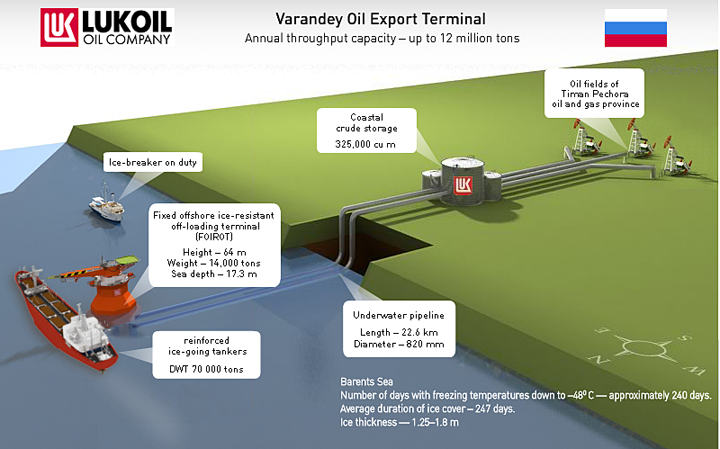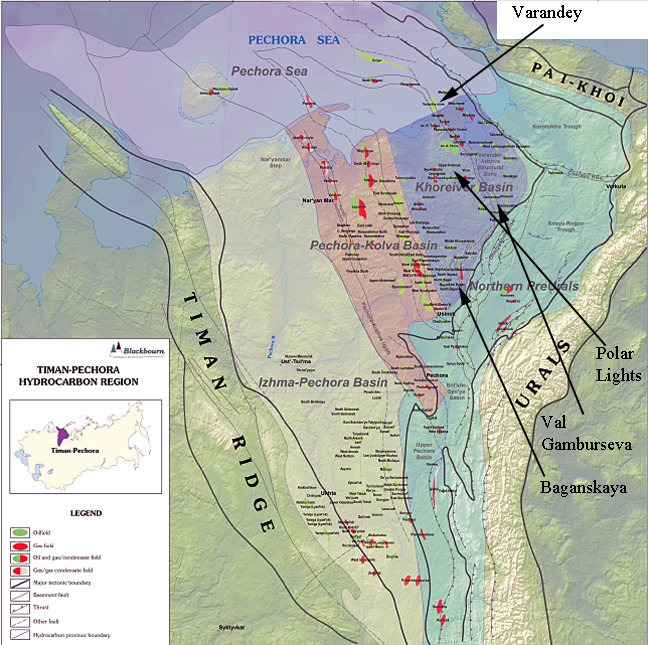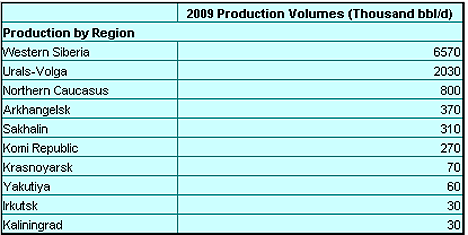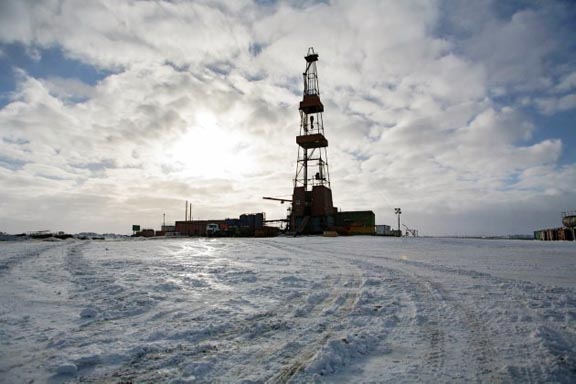Tech Talk - Oil Production from Timan-Pechora
Posted by Heading Out on February 19, 2012 - 5:50am
In the review of the BP view of energy supply over the next 20 years, I noted BP anticipated that Europe would be largely self-sufficient in Energy:
we foresee both the Americas and Eurasia - or Europe including Russia and the former Soviet Union - achieving self-sufficiency in energy
Foregoing, as yet, is a review of the FSU states that lie south of Russia. The initial question that this series is seeking to examine at present is how sustainable, or how much potential for growth, lies in Russian oil and gas production.

This progressive review of Russian major oil developments has moved from Baku and the Northern Caucasus, through the Urals-Volga region into Western Siberia, and thence via Eastern Siberia to Sakhalin Island. This has been a steady progression East, and one might suspect that Russia might continue this movement as current major fields start to play out. Unfortunately, that would move exploration and development east across the Bering Sea. In 1868, Tsar Alexander II sold Alaska to the United States for $7.2 million in gold, and much of that resource has now been developed. (And as an aside, the Alaskan pipeline averaged a flow of 624,716 bd in January, enough to keep it out of trouble this winter, we hope).
So if Russia cannot move further east, then the option remaining is to move north. And that brings us initially to the fields of the Timan-Pechora Basin, which the Rosneft subsidiary Severnaya Neft ships out of Arkhangelsk, and the oil that Lukoil and their partners produce, which ships out of the Varandey Oil Export Terminal on the Barents Sea. The total basin is now producing at around 640 kbd, of which some 540 kbd is being exported.

The Varandey Oil Terminal (Lukoil)
It is expected that the terminal will also provide a path for JSC Zarubezhneft, who is just starting production in the Central Khorovey Uplift. The fields are anticipated to produce some 800 million barrels of oil, but over a 57-year period, with maximum production only reaching 128 kbd in 2021. (The Vietnamese have part of this project).

Back in 1999, the USGS estimated that the total extractable reserve was around 20 billion barrels of oil equivalent (bboe), of which 66% was oil. Part of the problem in defining how this ranks relative to the table that I posted when writing about Western Siberia, comes from the regions in which the basin lies.

Timan-Pechora lies in the Komi Republic, the Nenetsk Autonomous Okrug, and in the Arkhangelsk region, so that presumably one adds numbers in the table above to get the total production from the basin. Most of the production to date has been onshore, though some 3.38 bboe of the total reserves are anticipated to lie above the Arctic Circle.

RN-Severnaya Neft is producing from 17 fields, with most production centered around the Baganskaya and Val Gumburtseva regions, for a total of 82 kbd in 2010 from 277 wells, with 10 added in 2010. They also have a joint venture with ConocoPhilips known as Polar Lights, which had an average daily output of 14 kbd in 2010, though rising from initial development in 2008. However, this is from 28 wells, but they only appear to be adding one well a year.
The major producer in the region is Lukoil who produces the recently discovered Bayandyskoye field with a planned production of 150 kbd, with reserves of 200 million boe. They found a second new discovery of comparable magnitude last November in the Vostochno-Lanbeshorsky field.
It is through discoveries like these that anticipated production will rise, overall. However, some of the increase will come as production moves offshore into the Trebs and Titov fields.
The development of the two offshore fields was originally licensed to Bashneft-Polus, but Lukoil has just bought 25.1% of that company for $150 million. (On a rough measure, each field is considered to hold about half-a-billion barrels of reserves.) It has been estimated that it will require between $5 and $6 billion to develop the fields and Lukoil may need the boost in production, since it saw oil production fall 5.5% last year. This was partly due to a lower than anticipated yield from the Yuzhno-Khilchuyu field being developed with ConocoPhilips. The anticipated production from that field was expected to be 150 kbd, with reserves of around 500 million barrels. The total acreage that the partnership controls is, however, greater than the current development, and contains other fields within the Naryanmarneftfaz collaboration.

Total production levels from Timan-Pechora are projected to reach levels of around 750 kbd by 2020. Yet, as with Eastern Siberia and Sakhalin Island, production in these fields is not going to be that easy. Back in 2005 John Grace (Russian Oil Supply) described it thus:
Geography also dealt the basin a very severe climate. It is substantially north of the oil-producing area of West Siberia, and its proximity to the Arctic Ocean makes it snowier and windier. With the exception of the Yamburg gas field in northern West Siberia, nowhere in Russia is a substantial volume of oil or gas produced from a worse place to work.
Production increases that are being discussed are only on the order of 100 – 200 kbd, and will require production from a number of fields to provide that volume. While the quality of the oil coming from Timan-Pechora is high, thus helping Russian income, the incremental volumes will not do a lot to provide that sustained production from Russia that the world seems to anticipate will happen.
UPDATE: I should have mentioned that the Prirazlomnoye oil field operated by Gazprom is also scheduled to come on line this year. With an anticipated production of 132 kbd it has a reserve of around 500 million barrels, and will be producing from 40 wells. It is 60 km offshore, in about 60 ft of water, and will supply oil to Varandey. In addition the Kolvinskoye oil field has just come on stream, with 24 wells projected to produce an average of 90 kbd by the end of the year. Again reserves are estimated at around 500 mb. These two oilfields are the reason that the February 2012 OPEC MOMR sees a slight gain of 70 kbd in overall production from Russia this year.




Timano-Pechora Oil
http://www.gecon.ru/bib/bibs/gecon/papers/NGV2004_4%20NeftTPP58-67.pdf
Oil of the Volga region
http://www.gecon.ru/bib/bibs/gecon/papers/NGV2004_6.pdf
LukOil Largest Oil Field
http://www.lukoil.ru/materials/doc/Books/2007/DB2007/part03.pdf
http://www.lukoil.ru/materials/doc/Books/2008/DB2008/part03.pdf
http://www.lukoil.ru/materials/doc/Books/2009/DB2009/part03.pdf
http://www.lukoil.ru/materials/doc/Books/2010/DB/part03.pdf
http://www.lukoil.ru/materials/doc/Books/2011/DB/part_03.pdf
HO,
Nice post, once again. Your series if tech talks are a real gem that TOD showcases to whomever stops by.
My question is not related to this post about Timan-Pechora, but to your overall direction/quest in these posts, which I assume is to eventually provide analysis for as much of the World as practicable.
Do you anticipate ever doing a tech talk on Antarctica?
Is there even any data to speak of?
I thought to myself 'Where is the end of the line for this series...the final frontier?'...Antarctica popped into mind.
H - Here is the short answer to your question: http://www.antarcticconnection.com/antarctic/science/geology.shtml
• In fact, no strong data show that hydrocarbon basins exist in the Antarctic. The mineral outcrops which have been identified are of no economic value, since the expense of mining and transporting them to markets would be prohibitive.
• The Antarctic Treaty's Protocol on Environmental Protection prohibits any mining or drilling for at least 50 years.
Grin:
At the rate at which I am working down from the top it may be a decade or so before I get down that far. Actually there will be a point where there is really not much point in looking at some of the smaller national levels of production, and I will revisit some of the earlier projections again down the road, so I doubt I will ever get that far - and Rockman gave a better answer.
I note the aside above.
"(And as an aside, the Alaskan pipeline averaged a flow of 624,716 bd in January, enough to keep it out of trouble this winter, we hope)."
What do you expect for Jan 2113, 2114 etc? What would be a dangerous level? Is there any late news from ANWR?
What do you expect for Jan 2113, 2114 etc?
Well it depends on whose crystal ball you use, Department of Revenue forecasts of North Slope production haven't been all that reliable in the past
Five years ago, the Fall Revenue Sources book forecast 782,000 bpd of production in FY2011 - a forecast that was off by 179,000 bpd.
Alaska's Department of Revenue noted this trend in the latest forecast: "When reviewing forecasted production versus actual production in previous production forecasts, it is apparent there has been a significant trend towards higher anticipated levels of production than those actually realized." The state incorporated a more in-depth review of the forecast, resulting in lower estimates this year.
With this approach the state forecasts that by FY2015 the total Alaska North Slope production will be 538,000 bpd, down from 603,000 bpd in FY2011.
all above came from here
The forecast production for FY2015 is in what is generally accepted as the safe zone for TAPS operation--though an unexpected cold weather shutdown like the one last winter might require using "safe" in quotes.
Though ANWR is not much in the news right now, this winter has been a big exploration year on the North Slope. Repsol, the Spanish oil and gas company, is a new player up there this season and they jumped in with a whoosh when they hit an unexpected gas pocket about 2600 feet under the tundra last week.
Right now the big battle up here is over the tax rate on oil production. The ConocoPhilips PR add supporting the governors plans to lower the rates is interesting. It ends by saying the governor expects lower tax rates will bring more oil company investment to Alaska rather than with any commitment from the oil company saying they will invest more if taxes are lower. Slick.
Clearly the forecasts had been biased to the upside consistently, likely to prop up state budget plans. Not a big surprise.
Will development of ANWR ever be considered as a last ditch effort to keep the pipeline flowing? If so, will there be economically recoverable oil?
there has only been one well, a tight hole (results confidential) actually drilled within ANWR (it was drilled on native land that sits within ANWR) and only one old school 2-D seismic shot back in 1984-85
So the short answer to your question we really don't know how much oil ANWR does or doesn't hold and we won't know until a real exploration drilling program puts holes in the ground to find out, but we won't even be ready to do that until a new 3-D seismic is shot.
It gets trickier to predict from there.
A 1998 Environmental Impact Statement from the Bureau of Land Management states: "because 3-D seismic involves more tight turns by heavy equipment than does 2-D, the potential for vegetation damage is greater. For this reason, it can be assumed that the medium and high disturbance levels to tundra would occur in greater proportions from 3-D seismic lines than that presented for 2-D."
That means even a new seismic is controversial.
Alaska ain't Texas where only 2% of the land in federal hands and almost everything else is privately owned. It is quite the reverse with only 1% of the land in private hands with another 10% held by native corporations. The federal government has title to 65% of Alaskan land and the various state and local government entities have title to the remaining 24%.
can you see the red dots (private land)? click the image for another window if you can't, that might help
ANWR itself is federal land,
which means Washington DC says what happens in it. That also means every US citizen and his/her dog (read lobbyist) can tell their congressman what they think the proper ANWR policy is...reduced TAPS flow should mean that pressure is mounting to get new seismic shot but I've heard not a peep from our Washington delegation specifically addressing that issue lately.
I do feel some of ANWR might get a new seismic shot in the next 3-6 years, just call that a hunch--Obama and Company could get political capital out allowing the seismic and then the real controversial base alienating decisions wouldn't have to be made until the another administration took charge---but Congress makes the calls so I won't wager on my hunch.
After that the real fight about drilling in ANWR would begin. If gas at the pump is north of $5-6 at the time I'd say the exploration drilling program happens (how big a program is anyone's guess, but I'd bet they have battle over just about every drilling pad, so fewer holes is more likely than more). Only then will we even have a chance to find out how much oil is or isn't under ANWR.
Quite a long string of events before we start talking about whether the oil that might or might not be under ANWR will ever be tapped to keep the TAPS oil flowing. Interesting that the acronym for the Trans Alaska Pipeline System is TAPS as in the bugle call which all too often signifies 'that's all she wrote.'
Well I've strayed pretty far east of eastern Siberia here, but prior its sale to the US in 1867 Alaska was part of Russia...so this sorta, kinda, almost relates to the key post ?-)
"Total production....... is expected to be 750K barrels per day". With plans to ship this entirely by sea through an area that is restricted by ice and may be subjected to ice sheet flow, I wonder if this amount of oil can really be produced. Are most large crude carriers able to operate in this environment?
Funny you should mention that. Not only has President Obama had a bit of a rethink, and decided to fund a new ice breaker, but the Russians have also started construction of a new "giant" icebreaker which, interestingly is shown clearing the way for a tanker. Maybe they got the idea from the "relief of Nome" - but I suspect not. It is the first of a new generation of ice breakers that are being built wider in order to help tankers. But they won't be appearing until about 2018.
Then after all that oil's gone the next step will be a galactic fighter spaceship a la "Starship Enterprise" to protect the Red Dwarf tanker ships trucking methane back from Titan. Or maybe a big rubber hose liking Earth with Titan, that way we won't need space tankers.
Most of the 750K bpd is existing production.